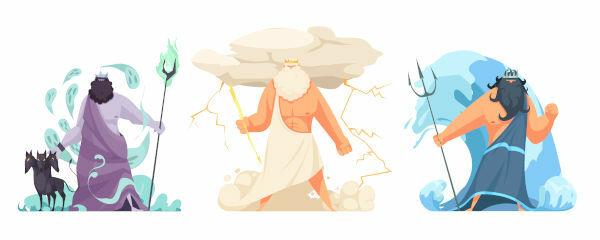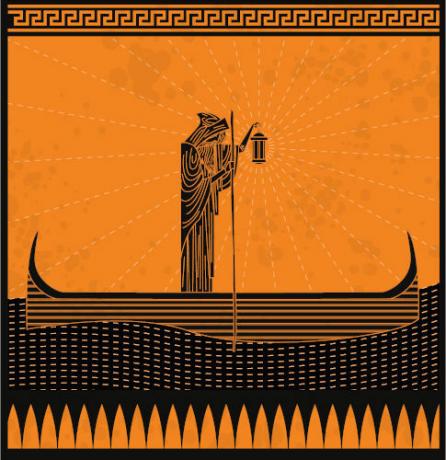Hades was one of the gods of Greek mythology, known as the god of the underworld, the place where the souls of the dead go. He was Zeus' brother and took part in the rebellion against Kronos, the titan who devoured his children. He married Persephone, a goddess kidnapped and taken to the underworld with him. The underworld was protected by Cerberus.
Accessalso: Meet Apollo, the Greek god of music
Who was Hades?
Hades was one of the gods present in Greek mythology, a set of myths that was part of the religiosity of the ancient greeks. Hades is known to be the Underworld god, the place within the Greek cosmogony to which the dead went. The underworld in Greek mythology is also known as Hades. Thus, the name can be used to designate both the god and the place where he reigned.

In Hades, the souls of the dead were judged according to their deeds in life, and those who had good deeds would have access to the
Champs Elysees, a resting place inside Hades. Those who had a life of bad deeds would be sent to the Tartarus, where the suffering would be eternal. Those who were awaiting judgment would receive it in Erebus.Hades X Chronos

Hades was one of the most feared Greek gods in Greek mythology and brother to Poseidon, Zeus, Demeter, Ivy and hestia. Hades was the son of Titanschronos and Rhea, and was one of those who participated in the battle against his father, known for devouring his own children. Zeus started a rebellion against Kronos, with him and his brothers emerging victorious.
After this battle, the three most powerful gods were each with a domain. Zeus got the earth and the heavens, Poseidon the seas, and Hades the underworld. That's why Hades did not reside on Mount Olympus, the abode of the gods, but in a palace in the underworld itself.
lord of the underworld
The fact of residing in the underworld created a great fear of the greeks as for Hades, and even the pronunciation of his name was avoided. Even so, offerings were made in honor of the god, both in Greece and in Pomegranate, animals used to be sacrificed. There is no evidence that human sacrifices took place. In Greece there were temples to worship Hades.
The god of the underworld was known to wear a helmet, made by hephaestus, which gave him the power of invisibility. This helmet has been mentioned in other passages, such as in Iliad, written by Homer, at the moment when the goddess Athena used it during the fight against Ares on account of Trojan War. Another passage quotes Perseus, a hero known to have fought and killed Medusa with the helmet.

during periods Archaic and Classic from Greek history, the god of the underworld was represented as a bearded man with a scepter in his hand. Hades was seen as a god insensitive, merciless and disgusting. There was an aide whose role was to protect the underworld from entering. we are talking about cerberus, the three-headed dog.
The souls reached the Hades-dominated underworld through Hermes, which guided them to the river Styx. there the boatman Charon crossed the souls across the rivers Styx and Acheron to the gates of the underworld. The boatman only made the crossing of those who received the proper funerary rites, which included placing a coin (in the eyes of the dead) to pay for the trip.
Accessalso: What would the end of the world look like for Viking Age Norsemen?
Hades and Persephone
![Sculpture depicting Hades kidnapping Persephone.[1]](/f/fc63a7c96e187a195faac2bf31aba109.jpg)
Hades' myth tells that he was in love with persephone, goddess of herbs, flowers, fruits and perfumes, and daughter of Zeus and Demeter. Hades decided kidnap Persephone and take her to the underworld. Persephone's mother, the goddess Demeter, was enraged at her daughter's abduction and launched a great famine upon the Earth, resulting in the deaths of thousands.
Zeus intervened by sending Hermes to the underworld with the instruction to ask Hades to allow his daughter to return, but Hades deceived Persephone and made her eat some underworld pomegranate.
By eating a food from the underworld, Persephone he couldn't leave the place anymore without Hades' permission. To resolve the issue, Zeus proposed that Persephone spend 1/3 of the year in the underworld and 2/3 of the year outside of it to be with her mother. The period Persephone spent with Hades was one of great sadness for Demeter.
This myth was used by the Greeks to explain the seasons, for Demeter was the goddess of agriculture, and her sorrow was used as the winter reason. The cold of this season, which impeded agriculture, was caused by Demeter's great sadness at being away from Persephone.
Image credits
[1] Madison Kayz and Shutterstock
By Daniel Neves
History teacher

